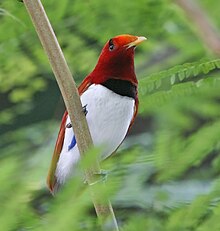King bird-of-paradise
| King bird-of-paradise | |
|---|---|
 |
|
| Male | |
| Scientific classification | |
| Kingdom: | Animalia |
| Phylum: | Chordate |
| Class: | Aves |
| Order: | Passeriformes |
| Family: | Paradisaeidae |
| Genus: | Cicinnurus |
| Subgenus: | Cicinnurus |
| Species: | C. regius |
| Binomial name | |
|
Cicinnurus regius (Linnaeus, 1758) |
|
The king bird-of-paradise (Cicinnurus regius) is a passerine bird of the Paradisaeidae (Bird-of-paradise) family.
The king bird-of-paradise is distributed throughout lowland forests of New Guinea and nearby islands. The diet consists mainly of fruits and arthropods.
An extraordinary courtship display is performed by the male with a series of tail swinging, fluffing of the white abdominal feathers that makes the bird look like a cottonball, and acrobatic movements of their elongated tail wires.
Widespread and a common species throughout their large habitat range, the king bird-of-paradise is evaluated as Least Concern on the IUCN Red List of Threatened Species. It is listed on Appendix II of CITES.
The first captive breeding of this species was by Dr. Sten Bergman of Sweden in 1958. He was awarded a commemorative medal by the Foreign Bird League to mark this achievement.
This so-called "living gem" is the smallest and most vividly colored among birds-of-paradise. The king bird-of-paradise is small, approximately 16 cm long. The male is crimson and white with bright blue feet and green-tipped fan-like plumes on his shoulder. The two elongated tail wires are decorated with emerald green disk feathers on its tip. The unadorned female is a brown bird with barring below.
...
Wikipedia

